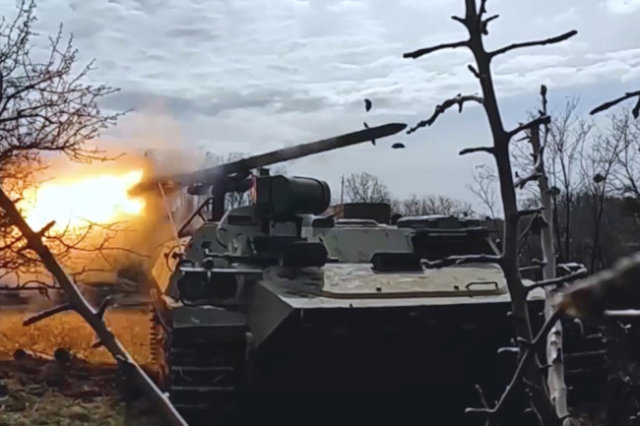The Russian Ministry of Defense has published footage of calculations of self-propelled anti-tank missile systems "Sturm-S" and portable anti-tank missile systems "Fagot" during a military special operation in Ukraine.
The capabilities of the Sturm-S self-propelled anti-tank missile system shown in the TV story are particularly impressive.
A self-propelled rocket and several tanks covered the guidance of the crossing in the area of the settlement of Grushevakha. The AFU combat group tried to interfere with the work. It consisted of one tank, three infantry fighting vehicles and a truck with infantry. The enemy group was spotted at a distance of two kilometers from the crossing. The terrain features did not allow the tanks to conduct effective fire. The crew of the ATGM "Sturm-S" took up the case.
The first missile destroyed the enemy tank. The cumulative jet hit the firing pin, which detonated, as a result of which the tank was literally torn to shreds. Then two infantry fighting vehicles and a truck were destroyed. The surviving infantry fighting vehicle and several soldiers who managed to jump off the truck escaped.
"Sturm-S" is recognized as one of the best guided missile systems. It was developed in the 1970s at the Kolomna Design Bureau of Mechanical Engineering under the leadership of the legendary designer Sergei Pavlovich Invincible. Variants were created for ground forces, helicopters and warships. Over the past time, the complex has been repeatedly modernized. Now it is equipped with a single supersonic missile "Attack", which has various combat units. They allow the complex to be used against armored vehicles, fortified points, dispersed infantry and helicopters at an altitude of up to 3000 meters.
Special programs have been developed to control firing, which allow the rocket to fly both along the line of sight and along the trajectory above the line of sight at the initial stage. When approaching the tank at a distance of 500 meters, the rocket descends to the level of the silhouette of the target and is guaranteed to hit it.
The land version is located on the basis of a floating light tracked tractor MT-LB. With a mass of 12.3 tons, the Sturm-S can reach speeds of up to 70 km/h on the highway.
The high thrust-to-weight ratio of the MT-LB, the presence of a crawler and a low specific pressure on the ground make it possible to effectively use the complex in various natural and climatic conditions and off-road. The layout of the launcher and other equipment makes it possible for the crew of the combat vehicle to fire from an openly positioned position, an engineering-equipped shelter, as well as from the water surface when the MT-LB is moving by swimming.
In the forward compartment of the hull there are workplaces of two crew members - the driver and the commander-operator. In the aft compartment there is a lifting launcher and mechanical laying of twelve transport and launch containers with missiles. Preparation for start-up is carried out automatically, taking into account the operator's commands. Moreover, the recharge occurs faster than the rocket reaches the target. The combat rate of fire is 3-4 rounds per minute.
Experts attribute a number of its most important characteristics to the main advantages of the Sturm-S complex. These are, for example, supersonic missile flight speed, high rate of fire and very high guidance accuracy. As well as the ability to hit a variety of ground, surface and air targets. The maximum firing range is 6000 meters. The guidance of the Ataka missiles can be carried out by radio commands and a laser beam.
Another anti-tank missile system shown by the Ministry of Defense is a portable "Fagot". It began to be developed back in 1963 in Tula, in the Instrument Design Bureau. The work was going hard. But in the end it turned out to be one of the most successful and powerful wearable missile systems. It has been repeatedly upgraded, maintaining its combat capability to the present time. Missile guidance is carried out at a range of up to 2.5 km. The complex is designed to defeat visually observed stationary and moving targets with speeds up to 60 km/ h.
Sergey Ptichkin

